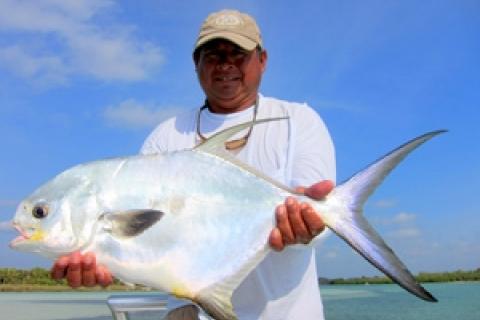
 If I were to wax mystically poetic when it comes to the pursuit of the Atlantic permit, perhaps I could postulate a three cornered piece of the world that would include the Bahamas, Miami to the Marquesas, the entire coast from Tulum, Mexico, throughout all of Belize and ending with the Bay Islands (Utila, Roatan, Guanaja) off Honduras. All of these marvelous places boast shallow water zones and flats that Quicksilver (trachinotus falcatus) comes in from the deeps to hunt on.
If I were to wax mystically poetic when it comes to the pursuit of the Atlantic permit, perhaps I could postulate a three cornered piece of the world that would include the Bahamas, Miami to the Marquesas, the entire coast from Tulum, Mexico, throughout all of Belize and ending with the Bay Islands (Utila, Roatan, Guanaja) off Honduras. All of these marvelous places boast shallow water zones and flats that Quicksilver (trachinotus falcatus) comes in from the deeps to hunt on.
For sheer numbers of permit, I would choose the stretch from Boca Paila, Mexico, to the southern border of Belize. Although there have been huge permit sighted, caught and released everywhere in the Triangle, my own experience points to the Miami to Marquesas long chain of flats. But the good news is that all of these places are wonderful.
Because permit are not true flats fish and spent only the higher water segments on flats crowns and flats edges, it will be necessary to pursue them on a flats boat. In the Triangle referenced above that means a skiff or a panga. And since permit are deeper bodied than bonefish, any vessel that floats and poles in a foot of water will be fine. There's no need for the super skinny water micro skiffs, as when anglers pursue smaller redfish on the flats of Flamingo or Pine Island Sound.
The key to understanding permit is to realize that these marvelous, super-spooky game fish are attracted to the kinds of crunchy bottoms and rock piles that are home to all sorts of crabs and hard-shelled prey. In fact, my IGFA ebraided linex-world record permit (just under 24 pounds on 4-pound test) was loaded with small black sea urchins. Permit also are attracted into hard pushing current vortices that carry shrimp and "pass" crabs along the flats. Permit possess the same kinds of crushers as bonefish and can easily pulverize a crab and blow out the shells.
There are three main types of tackle for permit. The first is a 10-pound spinning outfit rigged with a live silver dollar-sized crab. The second is the same spinner rigged with a crab colored skimmer jig, like the Backbone type. For spinning tackle I recommend an 8-foot long rod to keep as much line off the bottom and out of the water as possible. Because permit love rough bottom, try to use braided line. The final tackle type is fly fishing and I recommend a 9-weight rod rigged with the fly that your guide has recommended or the item popular in the region you are fishing.
As to casting presentations, if your permit is tailing intently put the fly or light lure closer to the fish. Because of the splash of a crab, cast it further away, then reel it on the surface and drop it to the fish. For sighted cruising permit, lead your fish more if the water is ultra calm or deeper to allow for sinkage. On rough windy days, your casts can be closer.
- 3586 views

